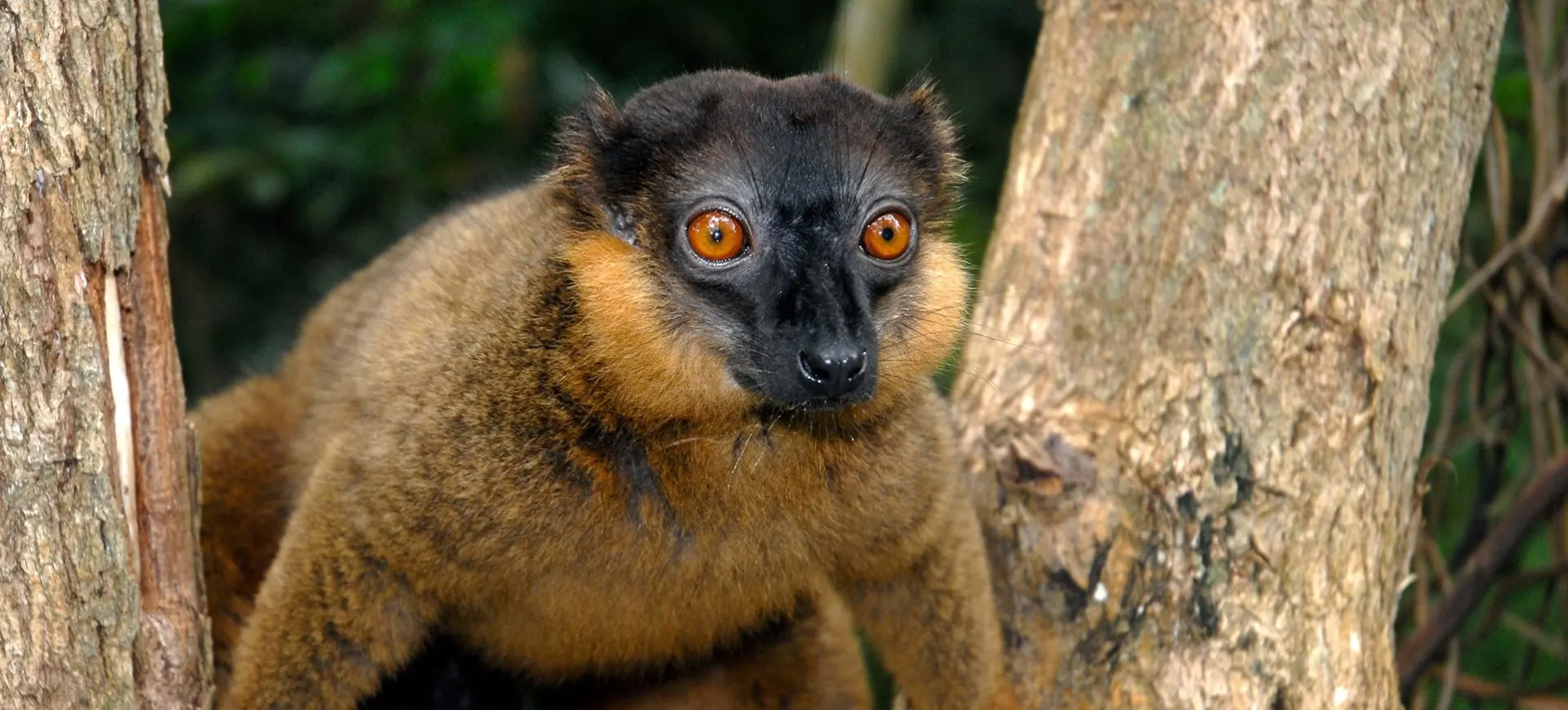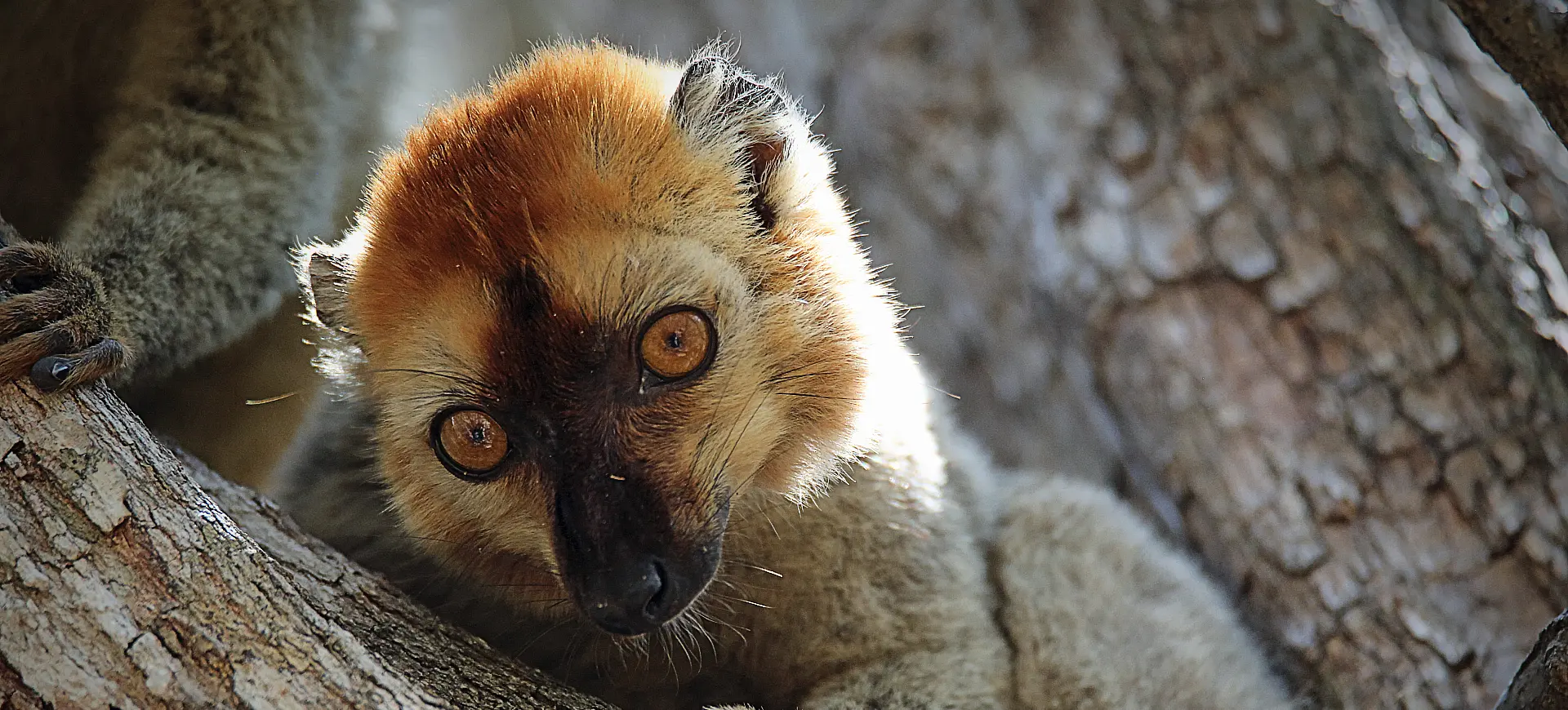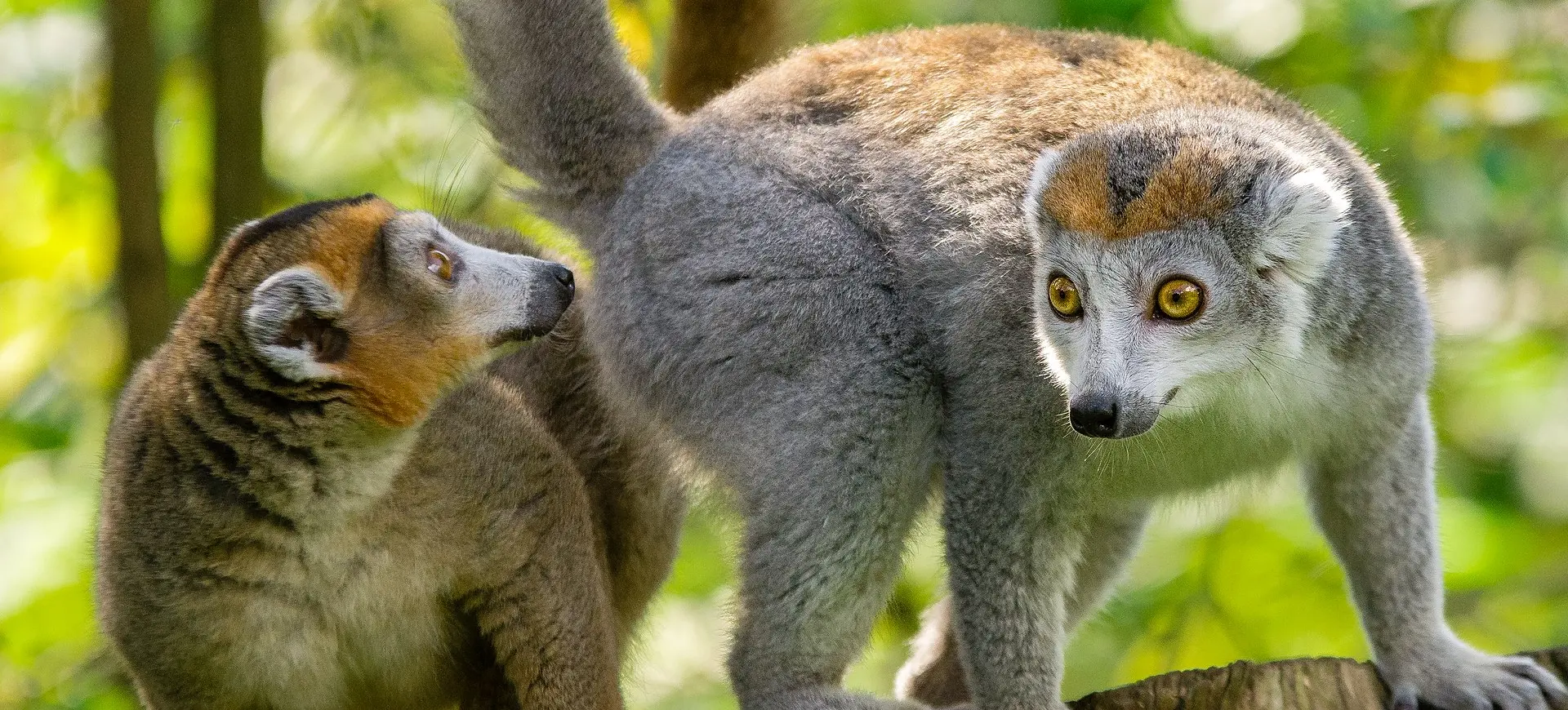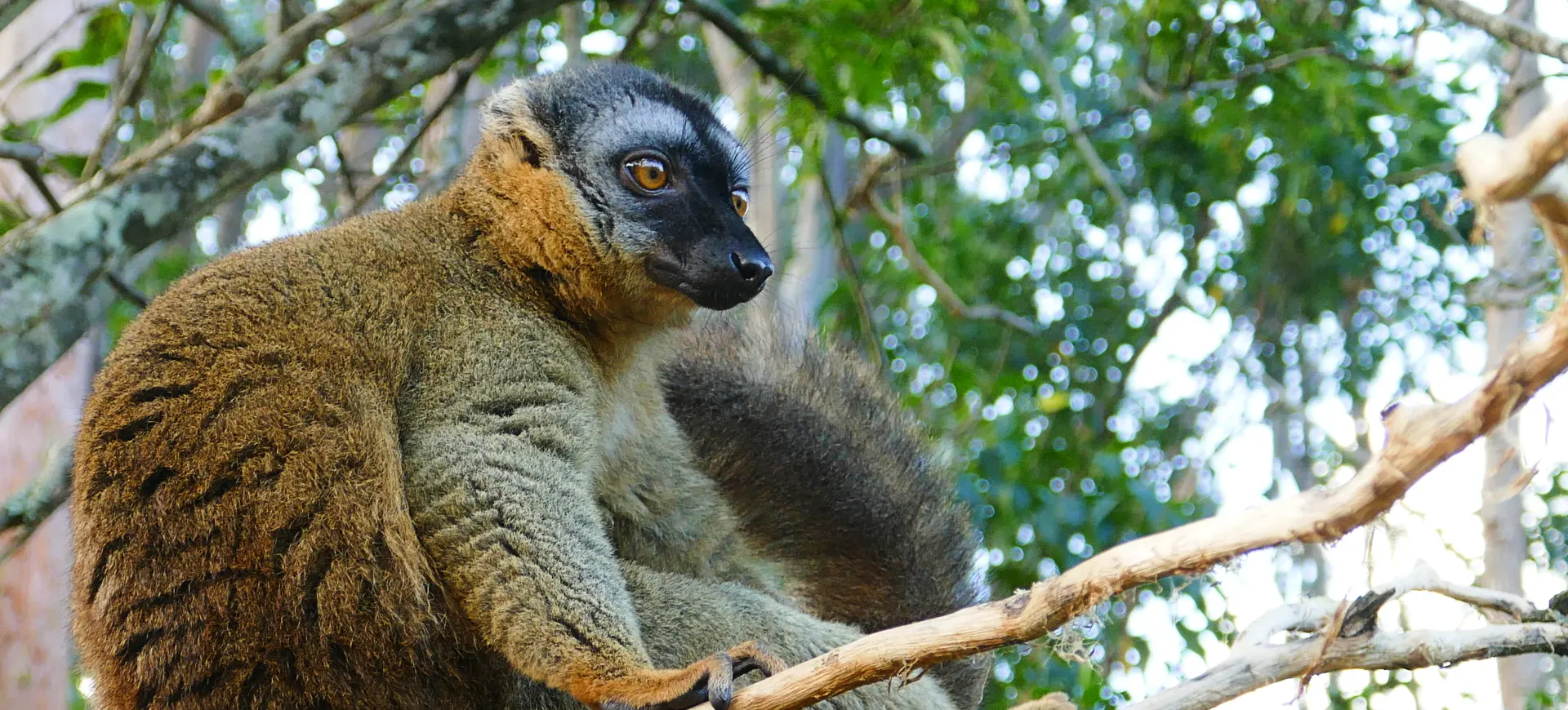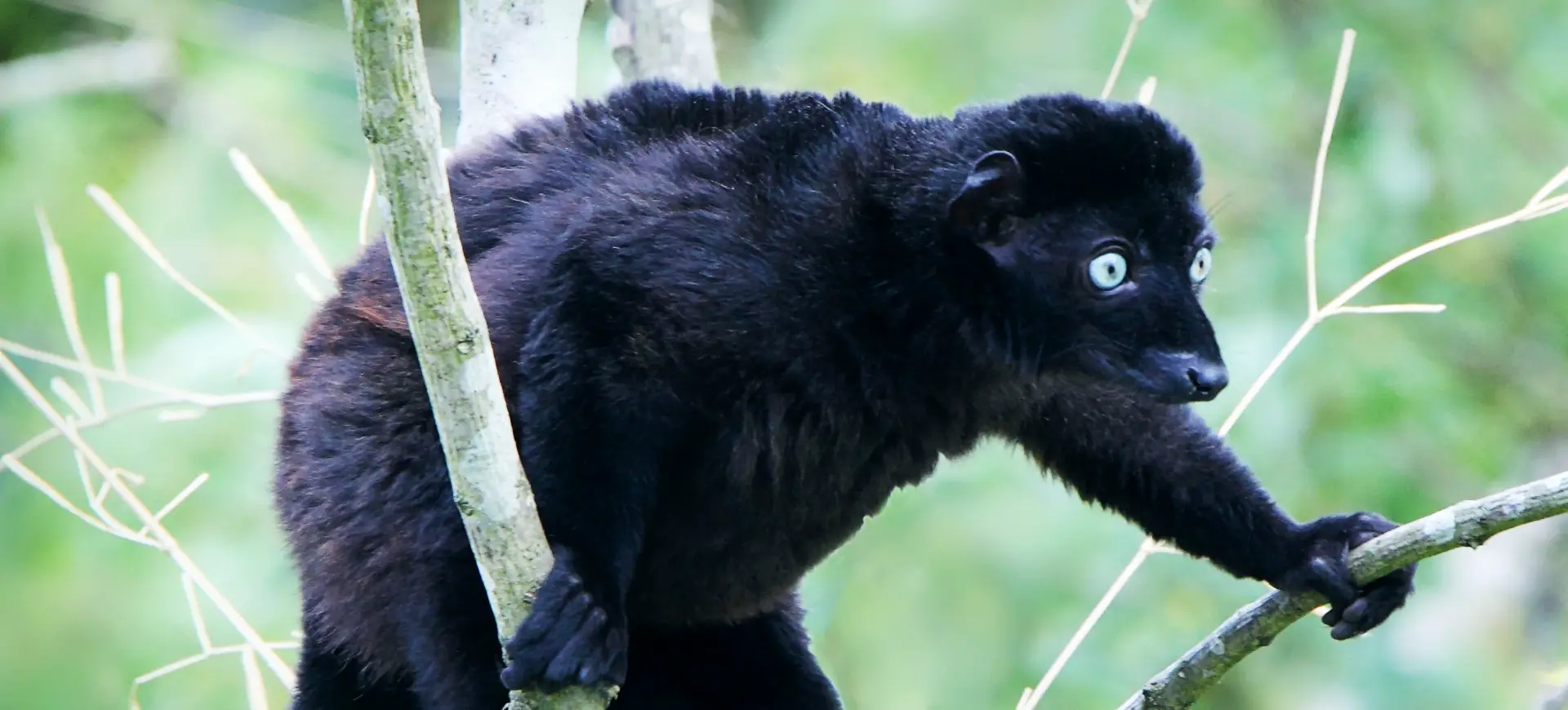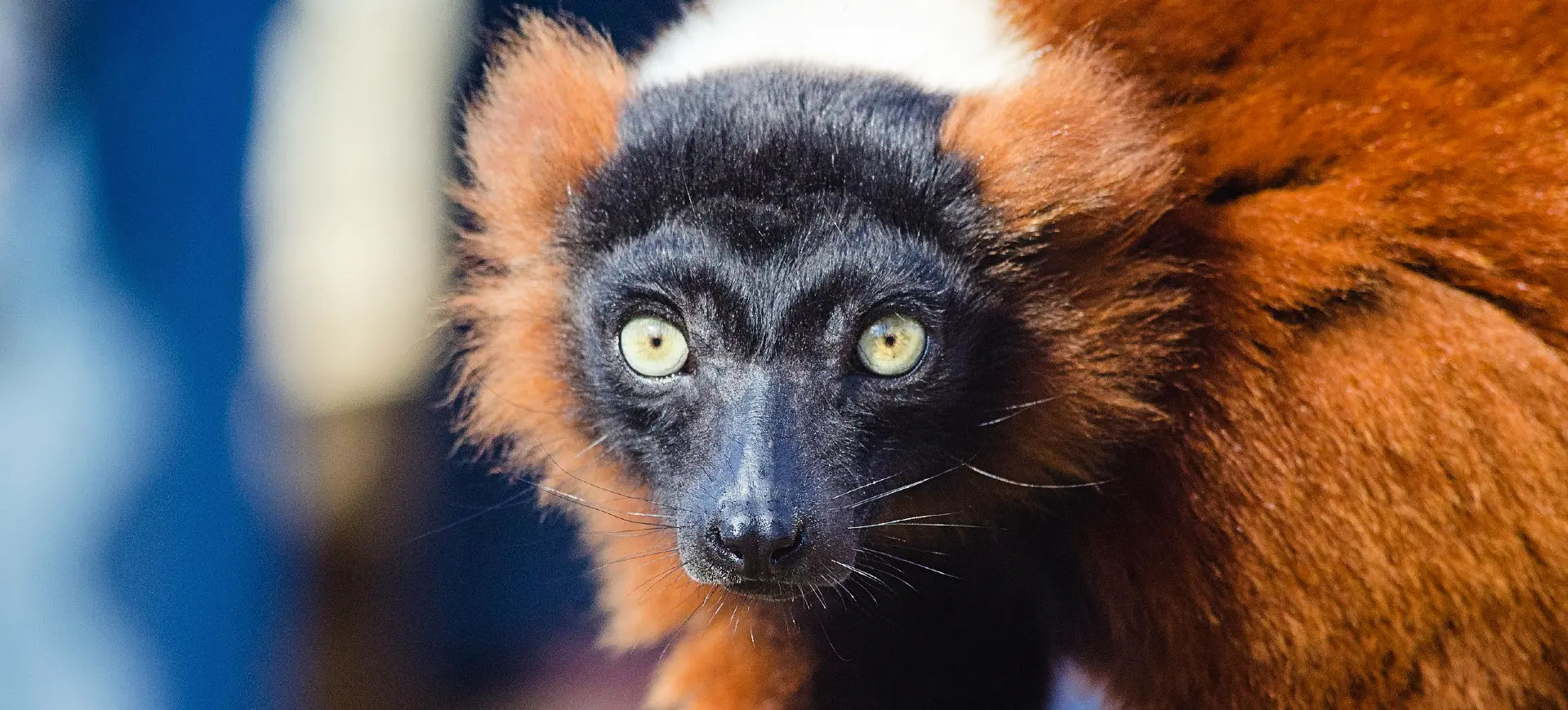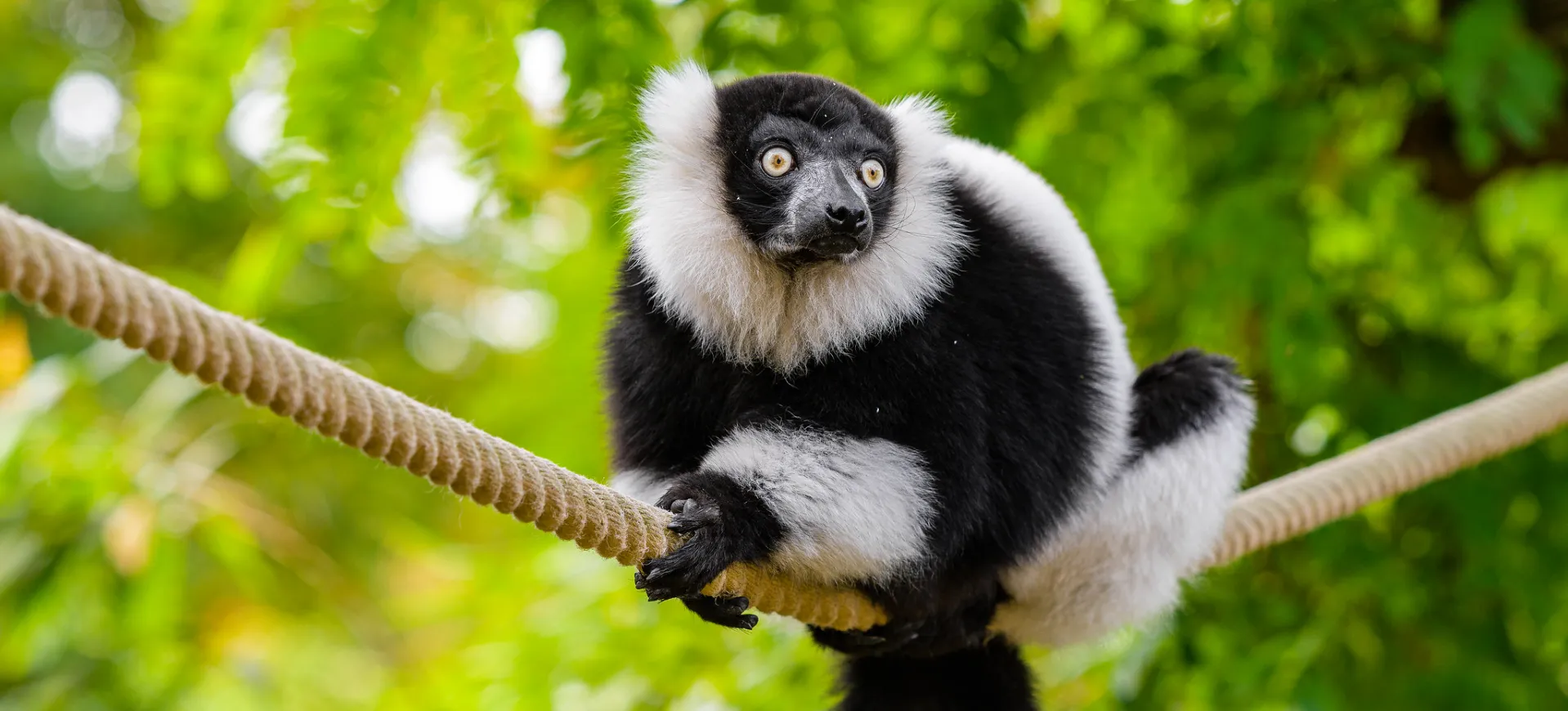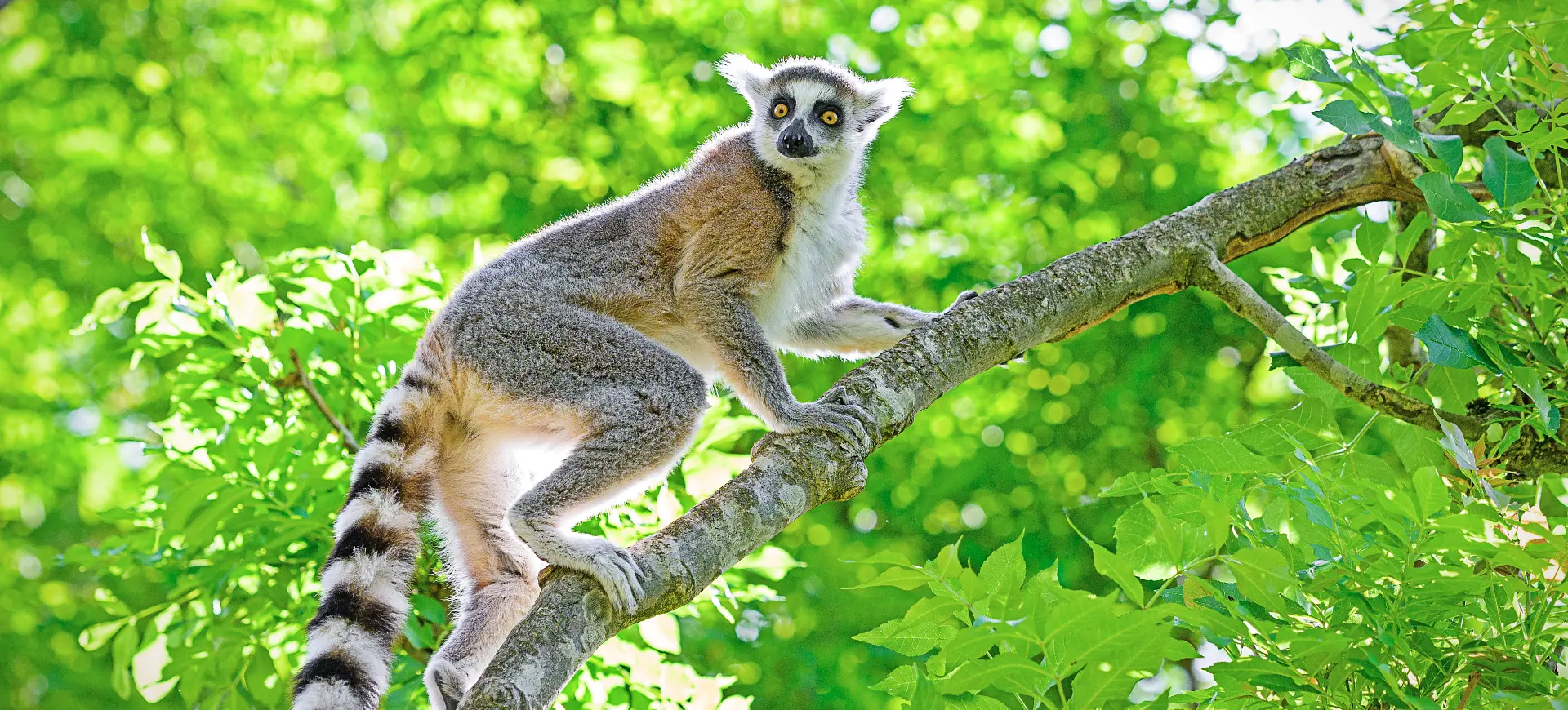Overview
The Mongoose Lemur (Eulemur mongo) is a small primate species endemic to Madagascar, with a small introduced population on the Comoros islands. This species is notable for its distinct seasonal changes in behavior and diet, adapting to the availability of food resources in its environment. Males and females exhibit slight sexual dimorphism, primarily in their coloration; males have grey-brown fur with a reddish-brown beard and crown, while females tend to have a darker grey coat with white beards. Both genders have large, expressive eyes, aiding their nocturnal and crepuscular activities.
In the wild, Mongoose Lemurs live in small, cohesive groups of mated pairs and their offspring, showcasing a strong bond and cooperative behavior within their social units. These groups occupy territories that they defend from other lemur groups, using vocalizations and scent marking to communicate their presence and establish boundaries. The species is known for its adaptability. It can live in various forest types, from dry deciduous forests to moist evergreen forests, demonstrating its versatility in navigating different landscapes for survival.
Despite their adaptability, Mongoose Lemurs face significant habitat destruction and fragmentation threats due to human activities such as slash-and-burn agriculture and illegal logging. These environmental pressures have led to a decline in their population, placing them in the category of endangered species. Conservation efforts are crucial for the survival of the Mongoose Lemur, focusing on habitat protection, reforestation, and the establishment of protected areas to safeguard their remaining natural habitats. The conservation of this species is vital for maintaining biodiversity and the ecological health of their forest habitats, where they play a key role in seed dispersal and forest regeneration.
Physical Description:
Mongoose Lemurs are characterized by their compact size and distinctive facial markings. They have a dense coat that varies seasonally, lighter during the wet season and darker in the dry season, which helps them blend into their forest environment. The male’s reddish-brown beard and crown distinguish it from the female, which has a white beard and lacks the reddish crown. Their expressive eyes are surrounded by dark patches, enhancing their night vision and contributing to their striking appearance.
Their body is built for an arboreal lifestyle, with strong limbs and dexterous hands that facilitate climbing and foraging in the trees. The Mongoose Lemur’s tail, which is nearly as long as its body, aids in balance but is not prehensile. This lemur’s physical adaptations, including its agile movements and the ability to leap between branches, underscore its evolutionary success in navigating the diverse forest habitats of Madagascar. The species’ compact size and agility are crucial for avoiding predators and efficiently exploiting the resources of their forested environment.

Lifespan: Wild: ~20 Years || Captivity: ~25 Years

Weight: Male & Female: 3.3-5.5 lbs (1.5-2.5 kg)

Length: Male & Female: Body 12-18 inches (30-45 cm) || Tail ~20 inches (50 cm)
Characteristic:
Native Habitat:
The Mongoose Lemur is native to Madagascar, with a preference for dry deciduous forests and more humid forest types along the west and northwest coasts of the island. They are also found in the Comoros islands, where a small population was introduced. Their habitat selection is influenced by the availability of food resources and suitable nesting sites, which are essential for their reproduction and survival. The species’ ability to inhabit a range of forest types demonstrates its ecological versatility and the importance of conserving diverse forest habitats for continued survival.
The fragmentation of their natural habitat due to human activity poses a significant challenge to the conservation of the Mongoose Lemur. Efforts to protect and restore these habitats are crucial, involving reforestation projects and establishing ecological corridors connecting fragmented forest areas. These conservation strategies aim to ensure the viability of Mongoose Lemur populations by preserving the ecosystems they depend on and promoting a landscape that supports their natural behaviors and ecological roles.
Climate Zones:
Biomes:
Biogeographical Realms:
Continents:
Countries:
Diet:
Diet & Feeding Habits:
The diet of the Mongoose Lemur varies seasonally, reflecting the changing availability of food resources in their habitat. During the wet season, they primarily consume fruits, which constitute the bulk of their diet and provide essential hydration and nutrition. As the dry season approaches and the fruit becomes scarce, they shift to a diet rich in leaves and flowers, demonstrating remarkable dietary flexibility. This adaptability is crucial for their survival in environments where food availability fluctuates significantly throughout the year.
Mongoose Lemurs employ a foraging strategy that relies on their acute senses of sight and smell to locate food. They are known to forage both in the canopy and on the ground, demonstrating versatility in their feeding habits. Social foraging is observed within their groups, allowing members to share information about food sources and increase the efficiency of their search for nourishment. The role of the Mongoose Lemur in seed dispersal and pollination highlights their importance in maintaining the health and diversity of their forest ecosystems, emphasizing the interconnectedness of species and their habitats.
Mating Behavior:
Mating Description:
The Mongoose Lemur exhibits a monogamous mating system, where a male and female form a pair bond that may last for many breeding seasons. This system is characterized by strong social bonds between the mating pairs, with both parents participating in the care of their offspring. Mating typically occurs at the onset of the wet season when food resources become more abundant, providing optimal conditions for raising young. Females give birth to a single offspring after a gestation period of approximately 120 to 128 days, with the young being highly dependent on maternal care for the first few months of life.
Parental investment in the Mongoose Lemur is significant, with both males and females contributing to the nurturing and protection of their offspring. This cooperative parenting strategy enhances the survival chances of the young, ensuring they receive adequate nutrition and learn essential survival skills. The social structure of their groups facilitates the sharing of responsibilities and resources, highlighting the importance of family bonds in the development and well-being of the offspring. The reproductive success of the Mongoose Lemur is closely tied to the stability of their habitat, underscoring the need for conservation efforts that protect their natural environments.
Reproduction Season:
Birth Type:
Pregnancy Duration:
Female Name:
Male Name:
Baby Name:
Social Structure Description:
The social structure of the Mongoose Lemur is characterized by small, tight-knit groups typically composed of a monogamous pair and their offspring. These family units exhibit strong bonds and cooperative behaviors, essential for survival in the complex forest ecosystem. Social interactions within groups, such as grooming and playing, strengthen familial ties and facilitate the transmission of social and survival skills to the young. Territorial behavior is common, with groups defending their home ranges from intruders, underscoring the importance of territory for accessing food and shelter.
The resilience of the Mongoose Lemur’s social structure is evident in its adaptability to environmental changes and habitat disturbances. However, the fragmentation of their habitat poses significant challenges to their social organization, potentially impacting their ability to find mates and maintain social cohesion. Conservation efforts that focus on habitat connectivity and the protection of critical areas are crucial for supporting the social dynamics of the Mongoose Lemur, ensuring the preservation of their social fabric and overall survival.
Groups:
Conservation Status:
Population Trend:
The population of the Mongoose Lemur is currently endangered, with numbers declining primarily due to habitat loss, fragmentation, and the effects of climate change. The conversion of forested areas into agricultural land and the impact of illegal logging have significantly reduced their living spaces, isolating populations and limiting their access to food resources. The situation is exacerbated by climate change, which threatens to alter the ecosystems they depend on, further complicating their survival.
Conservation initiatives are urgently needed to address the challenges facing the Mongoose Lemur. These include habitat protection and restoration efforts, creating ecological corridors to connect isolated populations, and implementing sustainable land use practices that minimize human impact on their habitats. Research and monitoring are also crucial for understanding population trends and the effectiveness of conservation strategies. By taking concerted action to preserve their natural environments, it is possible to halt the decline of the Mongoose Lemur and ensure its survival for future generations.
Population Threats:
The primary threats to the Mongoose Lemur include habitat destruction from slash-and-burn agriculture, illegal logging, and the expansion of human settlements. These activities fragment their habitat, severely limiting their range and access to essential resources. The illegal pet trade also risks their populations, with individuals being captured and sold, further depleting wild numbers. Climate change impacts, such as altered rainfall patterns and temperatures, add another layer of threat, potentially disrupting their food sources and breeding cycles.
To combat these threats, a multifaceted approach to conservation is required, focusing on the legal protection of their habitats, enforcement of wildlife trade regulations, and community-based conservation programs. Educating local communities about the ecological role and conservation needs of the Mongoose Lemur can foster a culture of coexistence and support for conservation efforts. International collaboration and support are also critical for amplifying conservation impact and providing the resources to protect this unique species.
Conservation Efforts:
Conservation efforts for the Mongoose Lemur are centered around habitat protection, with initiatives to establish and expand protected areas within their range. Reforestation projects seek to restore degraded habitats and increase forest cover, improving the quality and connectivity of their living spaces. Conservation breeding programs in Madagascar and internationally aim to bolster population numbers and maintain genetic diversity, with the potential for reintroduction into protected wild habitats.
Community engagement and sustainable development projects are key components of conservation strategies, offering alternatives to practices that harm lemur habitats. By involving local communities in conservation planning and implementation, these efforts aim to create sustainable livelihoods that reduce reliance on forest resources. Education and awareness campaigns further support conservation goals, raising national and international support for protecting the Mongoose Lemur and its habitat.
Additional Resources:
Fun Facts
- The Mongoose Lemur is one of the few lemur species exhibiting a significant diet shift between seasons.
- They have a distinctive vocalization used for communication within their group and to ward off potential threats.
- Unlike many other lemur species, the Mongoose Lemur can be active during the day and night, depending on the season.
- Thanks to their specialized metabolism, this species can consume fruits that are toxic to many other animals.
- The Mongoose Lemur’s monogamous relationships are a unique aspect of their social behavior, with pairs often remaining together for several breeding seasons.
- They play an important role in their ecosystem as seed dispersers, aiding in the growth of new plants and the health of the forest.
- Infants are carried by their mothers for the first few weeks of life before becoming more independent.
- The Mongoose Lemur’s tail is used for balance and signaling but is not prehensile.
- This lemur species is known for its ability to adapt to varying environmental conditions, showcasing a high degree of ecological flexibility.
- Conservation efforts for the Mongoose Lemur benefit the species and contribute to preserving Madagascar’s unique biodiversity.





